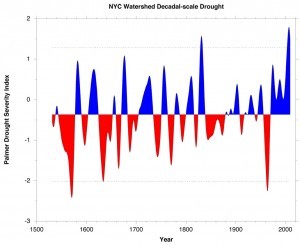All day long a flood of thousands scientists and students ebbs and flows across San Francisco’s 4th Street and Howard Avenue, coursing between the cavernous Moscone West and Moscone South convention buildings. The AGU is like a supercomputer of earth science, with human currents of data swapping information, heading from one talk to another, processing what they’ve heard, who they’ve met, what’s coming next.
What’s coming next in New York City, sooner or later, is a long dry spell, according to research by Lamont-Doherty’s Neil Pederson. The city has seen repeated shortages of water over the past 20 years — even though the climate has been relatively wet over the past few decades, and despite a decline in overall water use. Pederson says the water system emergencies of recent years suggest that “maybe the system is not in tune with the climate.”
Ultimately, he said in a talk today at AGU, New York City “is not prepared for the next significant drought.”


